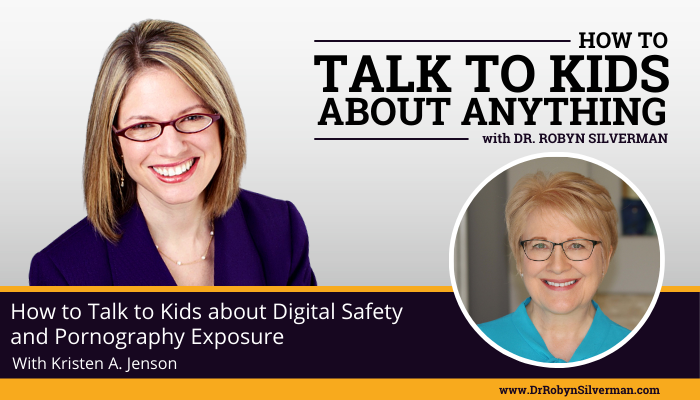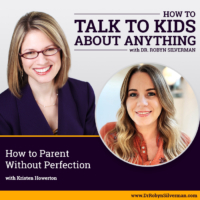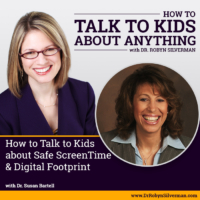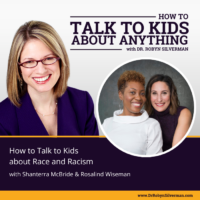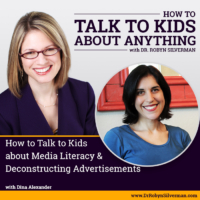Podcast: Play in new window | Download
Subscribe: Apple Podcasts | RSS | More
How to Talk to Kids about Digital Safety and Pornography Exposure
Do your kids know the difference between a “good picture” and a “bad picture” they find online? Pornography is dangerous for young minds—and if parents don’t talk to their kids about it, someone else might—and we may not like what they have to say. As the trusted adults in the lives of our children, our viewpoint and values are critical—and we know our children best. Dr. Robyn Silverman interviews the author of the #1 best-selling children’s book, Good Pictures, Bad Pictures, Kristen A. Jenson.
INTRODUCTION:
Whenever I speak to parents and key adults in the lives of kids about discussing pornography with children, they cringe. It’s an uncomfortable topic for many. And yet, we need to discuss it. Pornography is dangerous for young minds—and if we don’t talk to our kids about it, someone else might—and you may not like what they have to say. As the trusted adult, our viewpoint and values are critical—and we know our children best so we are the best people to talk to our children about these tough topics. So let’s get some pointers from our next guest!
Bio:
Kristen A. Jenson is the author of the #1 best-selling GOOD PICTURES BAD PICTURES books and producer of the BRAIN DEFENSE: DIGITAL SAFETY curriculum. She founded DefendYoungMinds.com to help parents and professionals raise empowered, resilient, screen-smart kids. Kristen has testified before the Washington State Senate on the public health crisis of pornography and continues to raise her strong voice at international conferences such as the United Nations Civil Societies Conference and the National Coalition to End Sexual Exploitation Global Summit. She is a trusted guest on a variety of media platforms as she speaks up for protecting children from all forms of sexual exploitation. Kristen is also the lucky mom of three and grandmother of two, and currently lives with her husband and awfully cute dog in Washington State.
Important Messages:
- You need to start with a definition. What is a good picture? Well, here’s all these examples of good pictures and we can see them all around us. But what’s a bad picture? And, you know, your definition of a bad picture can include a lot of things, but I keep it very simple. When you are dealing with young children, you really can’t afford to be nuanced You really just need to be direct and simple because that’s how their minds are thinking at that point.
- When they’re older and into their teenage years, you’re, you can be, there’s lots of nuance you can have there, but when they’re young, here’s a bad picture. Here’s a good picture. You’re not going to show them bad pictures, but you’re going to describe it in a way that they can recognize it when they see it. So they know, oh, I’m seeing a bad picture. I’m seeing somebody without their clothes on. That’s focusing on the private parts. This is pornography, or this is a bad picture and now I have to do something about it. So recognizing is that first step. So many kids may see something and they don’t know that this is problematic. So the first step is give them a definition.
- So in my book, how to Talk to Kids about Anything, I explain that many young people have seen pornography by age 11. That’s what the research said. So I encourage parents to talk about it earlier than they might like. When would you say we should be bringing up this conversation with kids? And why is that important?
- When a child has any access to the internet in your home or outside your home on a school bus, even three-year-olds are getting into porn and imitating it. These are in good homes. It’s just that, your kids are always one step ahead of you.
- All these kids are on iPads and other tablets and digital devices. So let’s give them a warning because, when a kid gets when your child gets old enough to run out into the street, you begin warning them. Don’t stop at the curb. Hold mom’s hand. Don’t run out into the street. A car could come and hit you. Well, when kids are allowed on the internet super highway, we need to give them a warning as well. We need to help them understand the dangers and what to do, if they come across these dangers.
- So this is one way to be safe. If you want to be able to use this iPad, we need to have these conversations about internet safety, and here’s one of them. So, if a child sees pornography by accident, which often happens that way, it can be very jarring for parents and for children. It would be easy to imagine a parent getting very upset or even angry or blame the child because, , what are you doing clicking on this? What do you want parents or key adults to say to kids if they see pornography by accident and they say something to you like, I just saw this.
- First of all, you should thank the child for coming and telling you honestly–thank them and tell them, good job. That was exactly what I want you to do. Remain as calm as you possibly can because if you get emotional and there’s this big blow up, they might not come and tell you again. Because they don’t want to get you upset.
- Guide called My Kid Saw Porn. Now What? And it, it goes through a smart plan, S-M-A-R-T.
- Stay calm.
- Make a plan.
- Assist your child to sort out feelings
- Regularly check in with your kids
- Train your family
- The brain is something that’s really impacted by pornography. Here’s what it can do to your brain. And here’s how your brain can become addicted. And really, the process that I set forth in good pictures, bad pictures is the same process of addiction no matter what the stimulus is, no matter if it’s a drug or another type of behavior.
- Porn Objectifies people. And you don’t want to look at a person like you look at a ball, right? A ball you can kick the ball isn’t going to scream, the ball isn’t going to be hurt. But a person, if you kick a person or hurt a person they are going to be hurt not only physically, but probably emotionally. And, and this is what you know, pornography often portrays is people being mean to each other. Mm-Hmm. And we don’t want to teach our brain that that’s, you know, really appropriate or acceptable. So ke giving kids lots of really solid reasons about why pornography is harmful they, they absolutely need that. You are right. They are going to hear that it’s totally normal, totally fine. And even necessary. And it is not, it’s harmful. It’s harmful to their brain, it’s harmful to their sexual development. It’s a toxic sexual script.
- IMPACT: It can impact the way that they look at other people, the way that they have a relationship with other people, their expectations for a romantic relationship and how they’re supposed to treat the, the other person or how they’re supposed to be treated. There’s a lot to that. And, and so to your point it, it can be harmful mentally and physically. And, and so we need to say it outright to our kids that pornography is harmful.
- What part of the brain are you using? Because when you see pornography, the part of the brain that is really activated is the feeling brain. You’re going to have that part of your brain activated. What you want to do is put the thinking brain in charge. And the way you do that is by labeling it. That’s pornography. And when you label it, you have more power over it.
- Distraction: replacement image– has emotional import to them, and then they think about that thing every time it pops in, the bad picture pops into their mind. What they’re doing is they’re creating a neural pathway away from the bad picture to something else that can distract them. Or watch a movie in your mind to distract.
- Physical exercise: And another thing they can do is get up and do something physical. Oh yeah. Requires a little bit of that requires their brain to be engaged as well.
- I want parents to be encouraged with a lot of hope that they have tools and you know, available to help them navigate what is probably the trickiest, most difficult time in the world for parents. Someday I hope we’ll have laws and other technology that will be in place so that our kids can be better protected from all of this stuff online. But we don’t have it right now. So we have to help them build an internal filter. So I want the parents to go away and be, you know, know that there are tools and resources and information for them available that wasn’t available, you know, 10, 15 years ago. And so, you know, to use those tools and to just be encouraged that you can make a huge difference in your child’s life by preparing them to reject pornography in all forms of sexual exploitation.
Notable Quotables:
- When you are dealing with young children, you really can’t afford to be nuanced You really need to be direct and simple because that’s how their minds are thinking at that point. “This is a good picture. This is a bad picture.”
- When a child has any access to the internet in your home or outside your home on a school bus, even three-year-olds are getting into porn and imitating it.
- All these kids are on iPads and other tablets and digital devices. So let’s give them a warning because, when a kid gets when your child gets old enough to run out into the street, you begin warning them. Don’t stop at the curb. Hold mom’s hand. Don’t run out into the street. A car could come and hit you. Well, when kids are allowed on the internet super highway, we need to give them a warning as well. We need to help them understand the dangers and what to do, if they come across these dangers.
- If your child comes to you when they accidently come across pornography, you should thank the child for coming and telling you honestly. Remain as calm as you possibly can because if you get emotional and there’s this big blow up, they might not come and tell you again. Because they don’t want to get you upset.
- Porn objectifies people. And you don’t want to look at a person like you look at a ball, right? A ball you can kick the ball isn’t going to scream, the ball isn’t going to be hurt. But a person, if you kick a person or hurt a person they are going to be hurt not only physically, but probably emotionally. And, and this is what you know, pornography often portrays is people being mean to each other. And we don’t want to teach our brain that that’s really appropriate or acceptable. It’s harmful to their brain, it’s harmful to their sexual development. It’s a toxic sexual script.
- It’s actually normal to feel enticed and excited by it. And that’s why it can be so powerful. This doesn’t make our children bad. It doesn’t make them wrong. It just is just a normal thing that can happen. It’s human.

